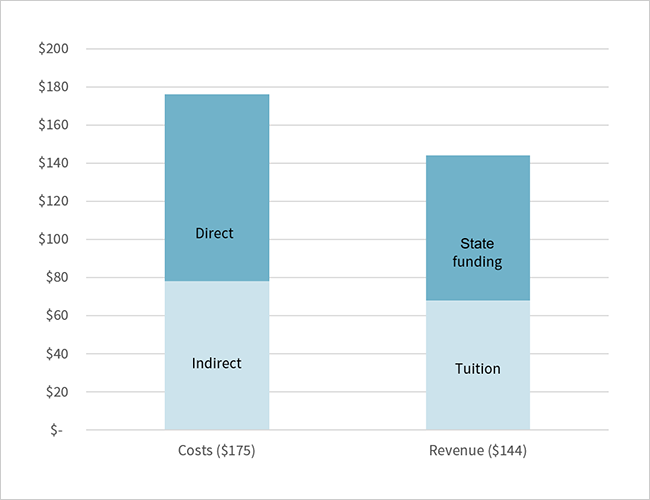Creating Stronger Student Success Interventions Through Financial Forecasting

Implications for policy and practice:
- College administrators should consider the costs and revenues associated with a new student success intervention (for example, enhanced advising) before adoption and implementation.
- State policymakers should train colleges in their state to make these calculations and provide estimates of marginal state funding per outcome (that is, the additional state funding a college would receive for producing one additional outcome, such as an enrollment). State policymakers can also use these forecasts to identify gaps in funding that they can fill so colleges are able to implement and sustain interventions that provide benefits to the state.
- Researchers should facilitate these forecasts by including cost analyses in their studies, providing effect estimates for outcomes commonly rewarded by state funding models, and developing tools to support forecasting. Cost analyses should present costs and revenues from the college perspective and make calculations transparent (for example, by clarifying the year and region where prices are based).
- College administrators, state policymakers, and researchers should account for state funding models that include equity premiums for students from historically marginalized groups.[1] College administrators in states with equity premiums should consider the financial effect of adopting interventions that target students in the relevant populations. State policymakers should demonstrate how the funding model encourages colleges to improve outcomes for students from historically marginalized groups. Researchers can help by publishing the estimated effects of interventions on the outcomes of students from these groups.
New student success interventions generate costs for colleges (for example, staff time and supplies). However, if they lead more students to remain enrolled, cause students to attempt more credits, and improve longer-term student outcomes, they can also generate tuition revenue and state funding (for public institutions in states that allocate funding based on enrollment, student outcomes, or both).
Forecasting the costs and revenues can help college administrators decide which interventions to adopt and to plan for financial sustainability.
In the absence of such forecasts, college administrators might choose not to adopt an evidence-based intervention based on a mistaken belief that the institution cannot sustain the intervention financially or, conversely, choose to adopt an intervention that the college cannot sustain and must ultimately discontinue. Such forecasts can create better alignment between evidence-based interventions and the colleges that can sustain them financially. They may also lead to the increased adoption of evidence-based interventions if college administrators would otherwise overestimate the unrecouped costs associated with an intervention or if risk-averse administrators would be biased toward the status quo in the face of uncertainty regarding the financial effect of a new intervention.
Additionally, forecasting the financial effect of a new intervention can help college administrators better plan for its financial sustainability. If a forecast shows that an intervention will not recoup all of its costs, college administrators might request funding from state policymakers or philanthropists to cover the gap. Administrators could also consider cutting the costs of the intervention to make it more financially sustainable, although such steps might counterintuitively make the intervention less financially sustainable if it becomes less effective and thus generates less revenue.
Forecasts of the financial effect of a new intervention should be conducted from the college perspective.
College administrators are typically the ones who decide to adopt a new intervention and must plan for its financial sustainability. However, interventions that increase retention and degree attainment create economic benefits for students (such as higher incomes) and society (for example, greater tax revenue and less dependence on public assistance) that the college does not capture. Forecasts from the college perspective are not intended to address whether a new intervention generates more benefits than costs from the societal perspective. As such, a forecast from the college perspective that shows an intervention is unlikely to recoup all of its costs does not necessarily mean that the intervention should not be adopted, particularly at a public institution with a mission to advance the public good.
There are three components in forecasting the costs and revenues of a new intervention that apply to all postsecondary institutions:
- Direct costs are the costs associated directly with providing the intervention.
- Indirect costs are the costs associated with changes in behavior resulting from the intervention, such as taking more credits.
- Tuition revenue, which may be paid by students or financial aid, is generated as a result of interventions causing more students to stay enrolled and causing them to take more credits.
State funding is also relevant for public institutions. Local funding may be relevant for community colleges, and auxiliary revenue is relevant for institutions that generate revenue from campus bookstores, campus housing, and dining services.
Calculating the costs and revenues resulting from a new intervention can be challenging for college administrators.
It can be particularly challenging for administrators at institutions that may not be able to invest significant resources in financial forecasting. It can be difficult to estimate the direct costs of a new intervention if previous studies of the intervention did not include a cost analysis or if a published cost analysis is not clear about the year and region on which the cost estimates are based. Estimating the indirect costs of an intervention requires a college to estimate its marginal costs per credit (how much it costs the college to deliver one additional credit), which can be tricky due to the mixture of fixed costs (costs that would be incurred regardless of the number of credits delivered) and variable costs (costs that increase as colleges deliver more credits). Estimating the tuition revenue generated by an intervention can be challenging due to institutional discounts (for example, scholarships awarded by the college) and a mixture of in-district/state and out-of-district/state students who may be paying different amounts. Last, estimating state funding can be complex because state funding models may reward multiple outcomes at different dollar amounts (for example, $2,000 per associate’s degree, $1,500 per transfer to a university, and $1,000 for a certificate), and because previous studies may not have estimated an intervention’s effects on the particular outcomes a state funding formula rewards, especially if those outcomes are in some way unconventional. State funding models also tend to change every 5 to 10 years, making projections of state funding uncertain.
Community college administrators MDRC has worked with have stated that they are aware of the components required for a forecast of an intervention’s costs and revenues, but it is rare for them to produce such forecasts due to the challenges involved in doing so. Of nine colleges that MDRC spoke with about forecasting an intervention’s costs and revenues, administrators at only two had ever attempted to produce such a forecast.
Research organizations have begun to develop tools to help colleges assess the costs and revenues associated with an intervention. HCM Strategists, rpk GROUP, the Institute for Higher Education Policy, and the American Council on Education have all developed a version of a “financial forecasting” or “return on investment” tool for interventions in the last five years. In the spring of 2022, MDRC launched its Intervention Return on Investment (ROI) Tool for community college administrators, the first such tool to include multiple interventions with estimated costs and effects on student outcomes already loaded; use rigorous effect estimates from randomized controlled trials; allow users to input their own interventions; cover community colleges nationwide; and be publicly available as a web application. For example, Figure 1 shows information generated by the ROI Tool on the costs and revenues associated with an intervention designed to encourage enrollment in summer courses, from the perspective of the Austin Community College District in Texas. While MDRC’s Intervention ROI Tool addresses many of the barriers described above for community colleges, it currently does not include universities or private, two-year institutions.
College administrators should become familiar with the process of forecasting intervention costs and revenues.
For example, administrators could learn how to adjust cost estimates based on inflation and regional prices and estimate their college’s marginal cost per credit, tuition revenue per credit, and marginal state funding per outcome (which may vary across institutions within the same state). Administrators of colleges in systems with funding models that include equity premiums (24 college systems each in the two- and four-year sectors as of fiscal year 2020) should also consider the financial effect of adopting interventions that target students whose improved outcomes can earn such premiums. If a college already has staff members responsible for the college’s overall financial forecasting (for example, in the office of the chief financial/business officer), it may make sense for such staff members to lead these efforts.
State policymakers should make it easier for colleges to forecast intervention costs and revenues.
For example, state policymakers could:
-
Train institutions in their state to produce such forecasts.
- Provide estimates of marginal state funding per outcome for each public college in their state each year, similar to the “component analysis” published by the Tennessee Higher Education Commission. In states with funding models that include equity premiums, such premiums should be included in the documentation.
- Produce forecasts for interventions they would like their institutions to adopt, identify gaps where intervention costs exceed revenues, and consider providing funding to fill these gaps and make the intervention financially sustainable.
Researchers can also make it easier for colleges to forecast intervention costs and revenues.
For example, researchers can:
-
Include transparent cost analyses in their studies that identify the year and region on which prices are based, disaggregate direct and indirect costs, and present costs and revenues from the college perspective.
- Provide effects on outcomes that are commonly rewarded by state funding models, such as credits attempted, enrollment, and credential attainment.
- Provide effects for groups that are commonly awarded premiums in state funding models (for example, students from low-income backgrounds and students of color).
Figure 1. Estimates of the Per-Student Costs and Revenues Associated with Implementing Encouraging Additional Summer Enrollment (a Communication Campaign and Tuition Stipend) at the Austin Community College District

SOURCE: MDRC’s Intervention Return on Investment Tool for Community Colleges.
NOTE: This figure assumes that the marginal cost per credit = $122; tuition revenue per credit = $85; marginal state funding per outcome = the default values used in MDRC’s Intervention ROI Tool.
[1]Equity premiums are provisions in state funding models that award additional funding to colleges for the enrollment of or outcomes achieved by students in historically marginalized groups. Examples of historically marginalized groups that equity premiums may award additional funding for include students from low-income backgrounds, students of color, students from rural areas, and students who are required to take remedial courses.
Austin Slaughter is a technical research associate in MDRC’s Postsecondary Education policy area.










